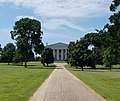Berry Hill Plantation
Berry Hill Plantation, also known simply as Berry Hill, is a historic plantation located on the west side of South Boston in Halifax County, Virginia, United States. The main house, transformed c. 1839 into one of Virginia's finest examples of Greek Revival architecture, was designated a National Historic Landmark in 1969.[2][4] The surviving portion of the plantation, which was once one of the largest in the state, is now a conference and event center.
Berry Hill | |
.jpg) Berry Hill | |
  | |
| Location | S of jct. of Rtes. 659 and 682, near South Boston, Virginia |
|---|---|
| Coordinates | 36°41′55″N 78°56′39″W |
| Area | 1,275 acres (516 ha) (landmarked area) |
| Built | 1839 |
| Architect | John E. Johnson |
| Architectural style | Greek Revival |
| NRHP reference No. | 69000246 |
| VLR No. | 041-0004 |
| Significant dates | |
| Added to NRHP | November 25, 1969[1] |
| Designated NHL | November 11, 1971[2] |
| Designated VLR | November 5, 1968[3] |
Description and history
Berry Hill is located on a site that is now about 650 acres (260 ha) in size,[5] between River Rd. and the Dan River on the west side of South Boston. The main house is a two-story brick structure, finished in stucco and topped by a gabled roof. The main facade is in emulation of the Parthenon, with eight massive Doric columns supporting an entablature and fully pedimented gable.[4]
With some 3,600 acres (1,500 ha) at its height,[6] the plantation was one of the largest in Virginia. The plantation has one of the largest slave cemeteries in Virginia, holding the graves of more than two hundred slaves, and includes well-preserved slave quarters.
The plantation was originally owned by Isaac Coles, who began using slaves in 1802. In 1814 and 1841, the plantation changed owners, finally ending up under the control of James Coles Bruce in 1832.[6] Bruce is credited with transforming the existing 18th-century brick plantation house then standing into the Greek Revival mansion seen today. Bruce is believed to have consulted with architect John E. Johnson, who designed Staunton Hill, the mansion of his half-brother.[4]
Today
The main house is now the centerpiece of the Berry Hill Resort and Conference Center, which provides accommodations and event facilities for weddings and corporate events.
Gallery
 Berry Hill in 2017
Berry Hill in 2017 Stone slave quarters
Stone slave quarters
See also
References
- "National Register Information System". National Register of Historic Places. National Park Service. January 23, 2007.
- "Berry Hill". National Historic Landmark summary listing. National Park Service. Archived from the original on 2008-01-01. Retrieved 2008-04-11.
- "Virginia Landmarks Register". Virginia Department of Historic Resources. Archived from the original on 21 September 2013. Retrieved 19 March 2013.
- Staff, Virginia Historic Landmarks Commission; James W. Moody Jr., Director (April 25, 1969). "National Register of Historic Places Inventory-Nomination: Berry Hill" (pdf). National Park Service. Cite journal requires
|journal=(help) and Accompanying three photos, exterior, from 1969 (32 KB) - "Rich History". Berry Hill Resort. Retrieved 2016-01-23.
- Sale, Edith Tunis (1909). Manors of Virginia in Colonial Times. Philadelphia: J. B. Lippincott Company. pp. 270–28 1.
External links
| Wikimedia Commons has media related to Berry Hill Plantation. |
- Berry Hill Resort web site
- Historic American Buildings Survey (HABS) No. VA-304, "Berry Hill Plantation, State Route 659 vicinity, South Boston vicinity, Halifax County, VA", 17 photos, 2 data pages, supplemental material
- Information on Berry Hill from Virginia African Heritage Program

